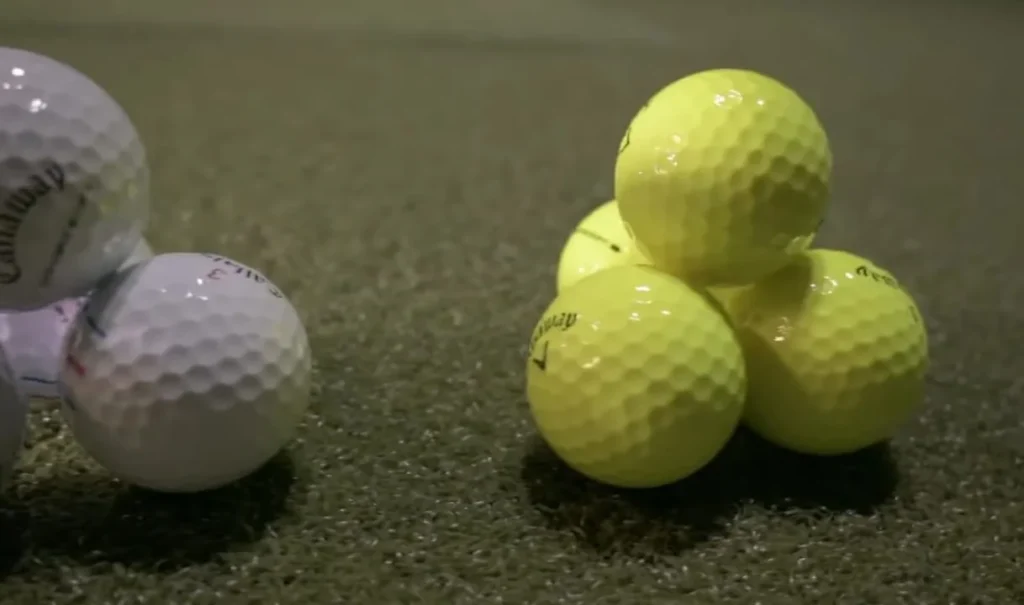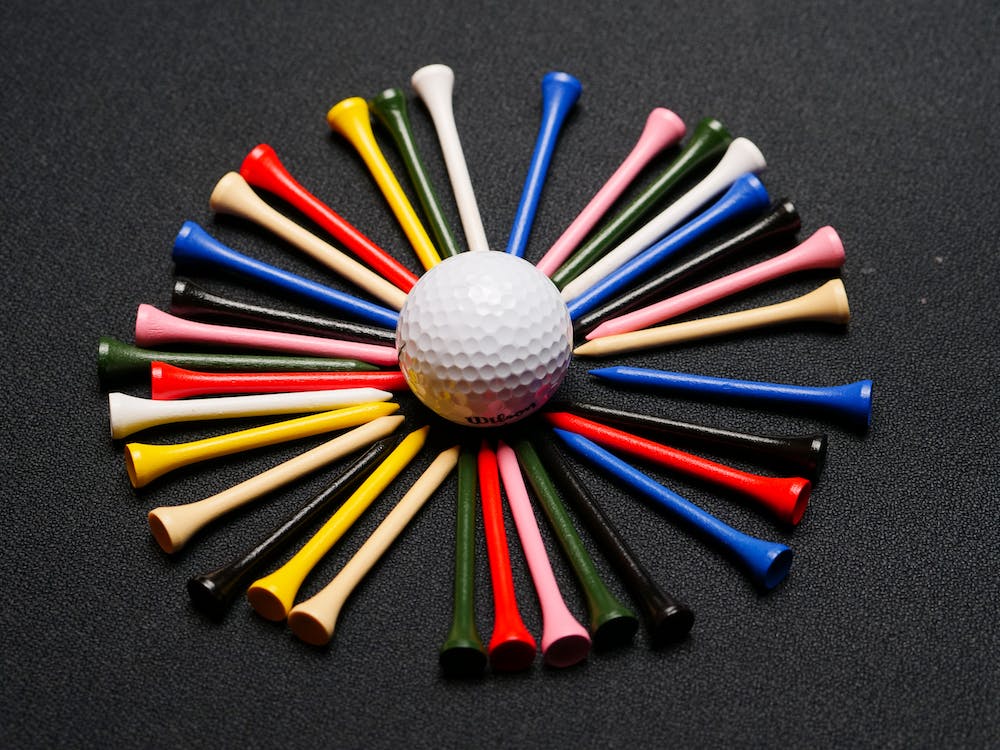At a time of rapid advancement in golf ball technology, the debate regarding high-compression vs low-compression golf balls remains heated among golfers of all skill levels. Understanding their differences is integral for optimizing performance on the course. That’s why, in this concise analysis, we’ll dive deep into the performance characteristics of these two balls. We will also take into account different considerations when choosing between high or low-compression models. If you intend to play well then first understand the difference between high compression vs low compression. So, let’s discuss both of these compression ratings separately.
We’ve already written an article on this very topic recently. So, if you wanna know what the term “compression” means for golf balls then give a read to our latest article on Golfing Gimmicks.

High-Compression VS Low-Compression Golf Balls: A Very Detailed Explanation
Understanding Compression in Golf Balls
Before delving into the high-stakes battle between high-compression vs low-compression golf balls, let’s address a fundamental mystery surrounding compression. Deformation upon the impact of a golf ball deforming upon impact is what determines its compression level. So, this seemingly small detail plays an integral role in how it performs during gameplay. When we are about to discuss high vs low compression golf balls, the only way to do justice to them is to talk about them separately. So, let’s start with high-compression golf balls.
High-Compression Golf Balls: The Power Players
Advantages of High-Compression Balls
High-compression golf balls with compression ratings of 90 or greater are designed for players with faster swing speeds and their inherent stiffness provides several advantages on the course. When choosing between high-compression vs low-compression golf balls, it’s important to pick the one that goes well with your swing speed. Here are a few reasons why high-compression golf balls might be perfect for you:
1. Maximizing Distance
One of the primary advantages of high-compression balls is their ability to maximize distance. Their firm core responds particularly well to powerful swings, translating that energy into long flights down the fairway.
2. Enhanced Control
High-compression golf balls offer more than sheer power; their firm feel gives experienced golfers greater control, which allows for precise shot shaping on challenging courses. You can control your shots better with these orbs.
3. Consistent Performance
Consistency is at the core of every successful golfer, and high-compression balls provide it. Their uniform performance guarantees predictable swing results every time out thereby creating confidence on every tee shot.
Suitable Swing Speeds for High Compression Balls
When choosing between high-compression vs low-compression golf balls, it’s important to go with the one that matches your swing speed. Now, high-compression balls excel when used alongside powerful swings to unleash their full potential and take full advantage of all that kinetic energy generated during powerful strokes. Some examples of high-compression golf balls include:
- Titleist Pro V1x
- TaylorMade TP5x
- Callaway Chrome Soft X

Low-Compression Golf Balls: Feel and Forgiveness
Advantages of Low-Compression Balls
Low-compression golf balls with ratings below 70 emphasize feel and forgiveness over sheer power, making them attractive options for various golfers. When you’re choosing between high-compression vs low-compression golf balls, it’s important to go with the most forgiving options. That’s especially important for beginners. The “high compression vs low compression” debate is closely related to the “faster swing speed vs slower speed swing” discussion. Let’s examine the advantages that may make these an appealing option.
1. Soft Feel
Low compression balls stand out with their soft feel upon impact, offering both greater comfort and increased feedback to enable players to connect more intimately with their shots. They are also less dangerous and softer upon impact (lessening injuries on the field).
2. Forgiveness
Low compression balls offer more forgiving responses for golfers who are still developing their skills or who take more relaxed swings, with extended dwell time on the clubface reducing off-center hits’ impact and providing consistency of performance.
3. Accuracy in Short Game
Precision around the greens is of vital importance in golf, and low-compression balls excel in this arena. Their soft feel provides better control for delicate shots that help players navigate more accurately around their putting surface.
Suitable Swing Speeds for Low Compression Balls
You have both types clarified sufficiently to you. When choosing between high-compression vs low-compression golf balls, never forget about the vital role swing speeds play. In short, low-compression balls are popular with players utilizing moderate to slower swing speeds. Their soft core provides ample cushion to absorb the energy generated during their swings for optimum performance. That’s why the high vs low compression golf balls debate exists in the first place. Now, some examples of low-compression golf balls include:
- Titleist DT TruSoft
- Srixon Soft Feel
- Bridgestone e6
Choosing the Right Ball for Your Game
Choosing between high-compression and low-compression golf balls starts with understanding your unique playing style and preferences. That’s why we have provided this breakdown so you can make an informed decision that complements your journey through golf. You have options to choose between high-compression vs low-compression golf balls; high-compression balls are more tightly wound than low-compression golf balls. However, as we’ve just stated, the debate about which ball is the best is individualistic in nature. In other words, go through the following factors before making a decision:
Assess Your Swing Speed
Step one of your journey begins by self-assessing your swing speed. High-compression balls are tailored towards those with quick swing speeds while moderate-to-slower swing rates should opt for low-compression balls instead.
Analyze Your Playing Style and Preferences
Consider your priorities on the course when making this choice: If distance and control are top priorities for you, high-compression balls may provide optimal performance; if feel and forgiveness are of primary concern then low-compression balls offer compelling alternatives.
Experimentation and Evaluation Process
Finding your ideal golf ball should ultimately come down to personal choice. Take time experimenting with both low-compression and high-compression balls so that you can assess their effect on your game. It’s all about trial and error; you gotta focus on paying close attention to feel, distance, and overall performance as you make an informed choice. That’s how you can find out the best option between high-compression vs low-compression golf balls.

High Compression VS Low Compression: A Comparison
Once we’ve examined the characteristics and advantages of high and low-compression golf balls individually, let’s compare their features side-by-side so you can grasp their differences in a better way and make more informed choices.
Direct Comparison of Key Features
Let’s go over what distinguishes high and low-compression golf balls. Choosing between high-compression vs low-compression golf balls is pretty easy once you realize how to do it right. So, here are some factors that you gotta keep in mind when deciding which one is the best option:
Compression Ratings
High-compression balls typically exceed 90 while low-compression ones remain under 70.
Feel
Firmer feel with high compression while soft touch from low compression golf balls.
Distance
High compression provides optimal distance performance while low compression prioritizes feel over sheer power.
Control
For enhanced control with reduced forgiveness, you should go with high-compression golf balls.
How Compression Affects Distance and Control?
Understanding compression science is vital to understanding its influence on distance and control. When met by fast swing, high compression balls produce powerful launches that maximize distance. Meanwhile, their firm feel allows precise control over ball trajectory.
On the contrary, low compression balls with their softcore sacrifice some distance in exchange for a greater feel and consistency in performance. Their forgiving nature ensures even off-center hits maintain some level of control resulting in improved overall playback. This is you a sensible golfer can decide between high-compression vs low-compression golf balls.

Conclusion
In golf’s ever-evolving game, choosing between high-compression and low-compression balls is not a one-size-fits-all decision; it should reflect your specific playing style and preferences. From powerful drives of high-compression golf balls to the subtleties offered by lower-compression alternatives – making an informed choice will bring greater enjoyment and satisfaction to of golfing experience. This is how you decide whether high vs low compression golf balls are the best golfing accessories for you today.
FAQs – High-compression vs low-compression golf balls
Do Softer Golf Balls Go Further?
Softer golf balls, often characterized by lower compression ratings, can offer advantages to slower swing speeds; their decreased compression allows these balls to compress more readily upon impact, potentially increasing energy transfer and potentially driving distance gains. Conversely, for faster swing speeds, these benefits might not be so evident; finding one with appropriate compression based on individual swing dynamics could ensure optimal results.
How Do You Check the Compression of a Golf Ball?
Determining the compression of a golf ball can be accomplished using various methods. Some of these methods have been discussed below:
Thumb Test
Press your thumb gently against the golf ball until firm yet comfortable pressure is applied and then observe any deformation or compression it experiences as time progresses. Soft golf balls will often compress more readily than harder ones.
Professional Compression Tester (PCT)
Use a compression tester, an instrument designed for this specific purpose. By placing a golf ball inside it and applying pressure, this tester will display your compression rating on its gauge. With such tools in hand, you should get accurate readings every time.
Specifications from Manufacturer
Referring to manufacturer specifications can provide useful details regarding compression ratings. Such data is typically printed or available online from manufacturers’ sites. Moreover, professional testing services may provide more precise readings when seeking data regarding golf ball compression.
Do Low-Compression Golf Balls Go Further?
Low-compression golf balls tend to create longer distances, particularly for players with slower swing speeds. Low-compression balls enable easier compression, creating maximum energy transfer from club head to ball and vice versa. Low-compression balls tend to produce longer carry distances, making them an appealing option for beginners, seniors, and players with less powerful swings.











